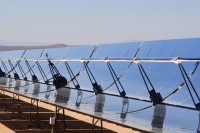Categories
- Additional Insured
- ChildrensProducts
- Claims Made
- Cyber Insurance
- Dietary Supplements and Nutraceuticals
- Ecigarettes
- Firearms Insurance
- Food Products
- Foreign Products Liability
- Foreseeable Misuse
- Frivolous Lawsuits
- General Liability
- Industrial
- Infographics
- Intellectual Property
- Looking ahead
- Marijuana Liability
- Medical Products
- Mutual Indemnification
- Nano Technology
- News
- Online Sellers Insurance Requirements
- Outsourcing
- Piercing The Corporate Veil
- Pollution Liability
- Product liability
- Product Recall
- Retail Chain Store
- Start-Up Business
- Statute of Repose
- Surplus Lines Insurance
- Technology
Solar and Hydrogen Energy Finally Coming of Age

What it means for your business
Solar energy currently represents only one percent of the world’s energy supply. But what if I told you that within the next 15 years solar energy could supply 100 percent of the world’s energy needs. That would be a massive 9,900 percent growth in an established industry.
But we’ve see this type of growth before. Only 14 years ago, back in 2000, there were only 100 million cell phones worldwide. There were many critics who denounced cell battery usage, size, cost and the limitations of technology as obstacles for making cell phone impractical for the average citizen. Of course, now there are billions of cell phones in the world. Even people in the poorest nations own cell phones and landlines are on the decline.
A case for solar energy
Solar efficiency has been doubling every two years over the past 30 years. At this rate of technological advancement, it will only take six more doublings, or 12 years, to meet 100 percent of world’s energy needs. In Australia, Spain and Germany it costs no more to install and use solar energy than to purchase electricity from the utility companies. At the current rate of innovation, by 2020 solar energy will be price-competitive with energy generated by fossil fuels, even without subsidies. Since 2010, the cost to purchase and install a solar energy system has dropped by 39 percent.
Japan is buying into solar energy in a big way with their 25-year plan to build the first satellite solar power plant. The Japan Aerospace Exploration Agency’s goal is to have a space station power plant that collects solar energy 24 hours a day and beams the energy back to earth using microwaves. The first solar power plant will generate one gigawatt of energy, which is equal to our largest modern conventional power plant.
While Japan’s solar satellite is an ambitious project, it may be totally unnecessary if catalysts for hydrogen batteries become less inexpensive. Hydrogen is the ideal fuel for storing renewable energy. However, the best catalysts currently used to create hydrogen, such as gold, platinum, iridium, and palladium, are just too expensive to make this cost effective.
Inexpensive catalyst being developed
Stanford scientists announced they have discovered that they can produce hydrogen by water electrolysis using inexpensive nickel and iron catalyst and an ordinary AAA battery. The same scientists also plan to create a water splitter that operates on electricity produced by solar energy.
While the Stanford researchers do not currently understand all the science behind their discovery, it has become evident that the race to develop inexpensive catalyst to create clean energy from hydrogen is being pursued by scientist all over the world. Countries such as China, Japan and Germany understand the competitive advantages associated with clean, inexpensive energy. As a result, any efforts by those lobbying to stop the development of solar, wind and hydrogen energies will be ultimately be defeated.
Hydrogen Batteries + Solar Energy = Energy Independence
The impact on countries adapting these renewable energies is a much reduced cost of doing business. In turn, products will be cheaper to produce, which is a boost to the economy. This is all excellent news in particular for renewable and green energy enthusiasts, farmers, manufacturers and conservationist in the U.S. If energy costs go down, we won’t be so dependent on overseas manufacturing because the cost of shipping will likely no longer offset the money saved in manufacturing abroad.
What else happens when energy becomes inexpensive? We’ll have access to unlimited clean drinking water from being able to boil ocean water and drink the condensation. Farming will no longer require vast acres of fertile land or pesticides, nor be susceptible to the whims of Mother Nature. Farms will be located near consumers in skyscrapers. Farmers will grow hydroponic fruits and vegetables without the need for expensive and environmentally harmful chemicals and pesticides. As solar and battery-storage technologies improve consumers will no longer be dependent on utility companies for power. We will have the energy to heat and power our homes and run equipment such as 3D printers to make our own consumer products.
China, Germany and Japan understand that these huge advances mean that the basic needs for humanity will be met. Hopefully, as this technology advances, governments around the world will embrace it and share this abundance with their citizens and make the world a better and less needy place.
Posted By: Paul L. Owens
-
 Click the Button Below to Get Your
Click the Button Below to Get Your
No-Obligation Quotes from Among the
Top 18 Leading Insurance Carriers Today -
Recent Industry News
- Amazon Sellers and Vendors Strategy Including Insurance Requirements
- Walmart Sellers Insurance
- Product Liability Limit Requirements of Online Sellers
- State-by-State Product Liability Analysis of Laws Impacting Businesses
- Children’s Product Liability: Strange Claims and Need for Insurance
- Product Liability vs. Environmental Insurance for the Chemical Industry
- Product Liability in the 3D Printing Industry: New Materials and Their Significance
- Product Liability Concerns in Agricultural Equipment Enhanced with Artificial Intelligence
- Navigate Product Liability in Battery and Solar Industry
- Cyber Risk Insurance Is Essential Business Insurance in Today’s Modern World
Monthly News Archives
